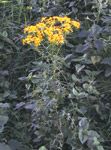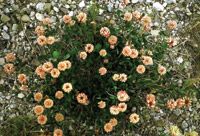Knowledge is key to safety; Plants that poison horses
Because antidotes are rare, plant-induced diseases in horses can be irreversible and sometimes lethal.
Because antidotes are rare, plant-induced diseases in horses can be irreversible and sometimes lethal.
Knowledge of which plants are toxic and when horses are likely to be poisoned will help reduce losses and ensure animal health and safety.
This series will introduce some common plants that poison horses in North America, describe poisoning and the subsequent plant-induced disease and outline current recommendations for treatment and management practices to avoid exposure.
Horses are relatively selective grazers and generally are poisoned less frequently than other livestock, but there are exceptions.
Some poisonous plants are palatable to horses and exposed horses readily eat them. Others may be eaten by some animals even though they are unpalatable to the rest of the herd.
Because some horses may actively seek and eat toxic plants, it has been suggested they become addicted to certain toxic plants. There is little experimental support for addiction, but individual horses do develop strong feed preferences. Such animals certainly are at greater risk of poisoning.
As a rule, both preferences and palatability are different when poisonous plants are dried and included in stored feed. Most horses readily accept toxic plants included in hay or processed feed. In herd situations, competition for food can enhance poisoning, as animals hurry to eat what they can or fight to keep lesser-status animals from eating.
Hepatotoxic plants
Besides processing dietary carbohydrates, lipids, amino acids, vitamins and micronutrients, the liver also is the primary organ that filters and detoxifies ingested toxins. It has limited responses to injury and many toxic, immunologic and infectious diseases result in similar hepatic lesions. This is especially true of chronic disease that nearly always results in cirrhosis (fibrosis, necrosis with nodules of regenerative nodular hyperplasia). This makes obtaining a definitive diagnosis difficult or impossible.
Hepatotoxic plants are a special challenge, because lower doses generally result in delayed onset. Often months or years are required for animals to develop clinical signs of liver failure, making documentation difficult. The following hepatotoxic plants are the ones that most commonly poison horses in North America:
Pyrrolizidine alkaloid-containing plants: (Seneciojacobaea- ragwort, stinking willie, tansy ragwort (Photo 1); S. integerrimus- lamb's tongue groundsel; S. longilobus- wolly groundsel, treadleaf groundsel; S. ridellii – riddell's groundsel; S. spartioides – broom groundsel; S. vulgaris – common groundsel; Crotalaria sagittalis – arrow crotalaria, rattle box, wild pea; C. spectabilis – showy crotalaria; C. retusa – rattlebox; Amsinckia intermedia – tarweed, fingerweed, fiddleneck, fireweed; Echium vulgare – blue thistle, blue devil, viper's bugloss; E. plantagineum – Patterson's curse, Salvation Jane; Heliotropium europaeum – Heliotrope; Cynoglossum officinale – houndstongue (Figure 2).

Photo 1: Senecio jacobaea (ragwort, stinking willie, tansy ragwort) is a noxious weed that is a native of the British Isles. It was inadvertently introduced into Western Europe, South Africa, Australia, New Zealand and North America. It is common in the northwestern states. Tansy ragwort is a tall (0.5m-1.5m), erect plant that is unbranched except at the inflorescence. In the spring it forms a tall, flowering stalk with composite heads that have terminal, flat-topped clusters about 1 cm tall and individual 1 cm long yellow rays. Each plant produces thousands of wind-dispersed seeds. Leaves are variably sized up to 22 cm long and 10 cm wide, with two or three deep pinnate divisions. It commonly invades well-drained pastures, forests and wastelands.
Most horses will not eat free-standing pyrrolizidine alkaloid (PA)-containing plants. Poisoning generally occurs when PA's contaminate hay or prepared feeds. PA poisoning in horses generally causes severe, irreversible liver disease.
Toxicity of the various plants is related both to concentration and type of PA. Concentration can vary between plants and between years. For example, PA concentrations from the same plants and location have varied from none to nearly 20 percent in sequential years, making it difficult to predict toxicity or evaluate risk.
PA-induced disease is determined by both the amount eaten (dose) and the exposure time (duration).
High PA doses cause sudden liver failure, but because most poisonings are from contaminated feed, doses usually are low and exposures are long. Clinical liver disease in these animals may not develop until months after exposure. Young animals are most sensitive and there are several reports of fetal and neonatal toxicity without evidence of maternal toxicity.

Photo 2: Cynoglossum officinale (houndstongue) is native to Euroasia, but has spread throughout North America. It is a noxious weed that invades pastures, rangelands and cultivated fields. A biennial, it forms a leafy rosette the first year, followed by flowering (A) and seed production in the second year (B). The plant is erect, hispid, usually 30 cm to 120 cm tall with large basal or cauline oblong-lanceolate leaves. The common name, houndstongue, comes from the tongue-like appearance of houndstongue's large, hairy leaves. The flowers are terminal and usually blue or purple. Later they form prickly nutlets (3mm-5mm) which entangle hair or clothing. It is commonly found as dense stands in moist or shady areas in fields and pastures.
Signs of poisoning are related to liver failure and include weight loss, weakness, sleepiness, yawning, incoordination, neurologic derangement, icterus, photosensitivity, aimless walking, chewing motions and head pressing.
Diagnosis is made by identifying exposure. As most poisonings are caused by contaminated feed, documenting exposure can be difficult. Hay contamination is patchy; often only a few bales from an entire crop may be bad. Finding the bad bales is difficult, so it often is better to inspect the field.
Though non-specific, good clinical work-ups and post-mortem examinations are helpful to narrow the diagnosis. Classical histologic changes of hepatocellular necrosis, fibrosis, biliary hyperplasia and hepatocyte megalocytosis are suggestive of PA intoxication. However, similar changes may be caused by aflatoxins and other alkalating agents.
In some cases, PA metabolites can be extracted and identified from animal tissues. Current research seeks to improve diagnostics to better identify and predict the outcome to poisoned animals.
As most cases result in liver failure, supportive care is the only treatment. As both contamination rates and PA concentrations within the plant can vary, assessing risk is impossible. Avoiding exposure to any of these plants is recommended:
Trifolium hybridum (aslike clover – Photo 3.

Photo 3: Trifolium hybridum (alsike clover), a perennial legume, is a short-lived forage plant that is included in many pasture-seed mixes. It often escapes cultivation and persists; it can spread in clusters to dominate pastures. The erect or ascending stems are 15 cm-70 cm tall and the leaves are oval and flat (~0.4 cm X 0.3 cm) in leaflets of three. It has many flowers (0.25 cm) with white to pink petals that fade to red-brown. It is most common in low, moist meadows and pastures.
Alsike clover is one of about 300 Trifolium species that have been associated with phytoestrogenism, slobbers, liver disease and photosensitivity. It is an introduced European plant that is included in some pasture mixes.
Several toxins have been suspected, but none has been proven. Toxicity may be related to environmental conditions and mold or aflatoxin production. Exposures of weeks to months generally are required before animals develop disease.
Three syndromes
Horses are the only species known to be susceptible to poisoning. Three syndromes have been identified.
The first, called "dew poisoning", is characterized by photosensitivity (sunburn), colic and diarrhea, depression or excitation.
The second, called "big liver disease" is severe liver disease or recurrent bouts of liver disease that is seen clinically as icterus, weight loss, CNS depression, anorexia, incoordination, dark and discolored urine and an enlarged fibrotic liver.
The third syndrome is associated with excessive salivation or slobbering, when horses eat clover that is infected with a fungus that causes brown leaf spot. Horses stop slobbering when exposure is discontinued.
Signs of poisoning depend on the syndrome and include anorexia, loss of body condition, jaundice, hepatoencephalopathy (neurologic disease) and death. Signs of other syndromes include sunburn with dermal edema, necrosis and sloughing of skin and possibly excessive salivation.
Treatment includes removing horses from exposure to the plant, treating photosensitivity and supportive care. Recovered animals often are hepatic cripples and more susceptible to liver failure or other liver diseases. It is recommended that alsike clover not be included in pasture seed mixes for horses.
Xanthium spp (Cocklebur).
Cocklebur seeds and seedlings contain a potent toxin called carboxyatractyloside, a plant-growth inhibitor that allows cockleburs to dominate competing plants. In animals, this toxin disrupts cellular metabolism, causing severe liver disease (centrilobular liver necrosis).
Poisoning most often occurs when horses consume feed contaminated with seed or when they eat small seedlings. The minimum lethal dose of seeds is 0.3 percent of body weight. All animals are susceptible to seedling poisoning.
Common signs include neurologic disease related to liver failure, depression, weakness, prostration, abnormal eye position and movements, paddling, convulsions and coma. Other changes include stocking up (swelling and edema of the feet and legs) and vasculitis. Severely poisoned animals generally die or are hepatic cripples that do poorly.
Diagnosis is made by documenting exposure and identifying blood-related changes of liver failure. Microscopic changes in liver cells and blood vessels can be detected in biopsy or post-mortem samples. Stomach or intestinal contents also can be analyzed for carboxyatractyloside.
Treating poisoned horses is symptomatic, with little response, as liver damage is extensive when animals become sick. It is important to mow or remove cockleburs before they form seeds and cause heavy infestations.
Crystalline hepatopathy – Panicum coloratum (Kleingrass), P. virgatum (switchgrass), Tribulus terrestris (puncture vine), Nolinatexana (sacahuiste), Agave lechuguilla (lechugilla).
These plants are native (Nolina, Agave, and Tribulus spp.) and introduced cover crops (Panicum spp.) that can be found across North America. Poisoning is variable and incompletely understood. Likely toxins include saponins (diosgenin and yamogenin) that damage the liver biliary system. Because toxin concentrations vary and poisoning is sporadic, risk is difficult to predict. Some animals never develop disease. Panicum grasses are not very palatable and are poor forages. In most cases, animals must be forced to eat them.
Poisoning signs usually are related to sunburn or photosensitization with elevated blood biomarkers and serum enzymes suggestive of liver disease.
Lesions include severe sunburn with necrosis and sloughing of skin. The photosensitivity cause is liver failure; characteristic microscopic changes of necrosis and bile-duct lesions can be seen in the liver.
It is difficult to predict dose or risk of poisoning, so horses should not be fed monocultures of these forages.
Treatment should include supportive care for both the liver disease and sunburn.
Precautions necessary
Because most poisoning occurs when hay and prepared feeds are contaminated, caution should be used when buying hay to ensure that it is safe and of good quality.
Because most weed infestations are patchy, the best way to do this is to inspect the hay before it is harvested.
Hay should be closely inspected when it is opened prior to feeding.
Other horses are poisoned when they are pastured with toxic plants with few other forage choices.
Most of these poisonings can be prevented by monitoring pasture and grazing animals.
For additional photographs and more detailed descriptions of the plants, toxic syndromes and toxin-related pathology, see Burrows and Tyrl 2001; Knight and Walter 2001; Stegelmeier 2005.
Dr. Stegelmeier is a researcher at the United States Department of Agriculture's Poisonous Plant Research Laboratory in Ogden, UT.
SUGGESTED READING
- Burrows, G. E., and Tyrl, R. J. (2001). Toxic Plants of North America, pp. 1-1277. Iowa State Press.
- Knight, A. P., and Walter, R. G. (2001). A Guide to Plant Poisoning of Animals in North America, pp. 1-367. Teton NewMedia, Jackson WY.
- Stegelmeier, B. L. USDA ARS Poisonous Plant Research Laboratory. USDA/ARS Location Website. 2005. Last updated 8-8-2006. http://www.ars.usda.gov/Main/docs.htm?docid=3496.
Podcast CE: A Surgeon’s Perspective on Current Trends for the Management of Osteoarthritis, Part 1
May 17th 2024David L. Dycus, DVM, MS, CCRP, DACVS joins Adam Christman, DVM, MBA, to discuss a proactive approach to the diagnosis of osteoarthritis and the best tools for general practice.
Listen